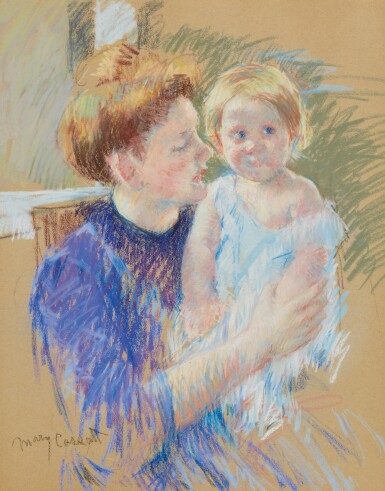American Art
American Art

Property from a Pennsylvania Collection
MARY CASSATT | MOTHER IN PURPLE HOLDING HER CHILD
Auction Closed
June 26, 03:10 PM GMT
Estimate
400,000 - 600,000 USD
Lot Details
Description
Property from a Pennsylvania Collection
MARY CASSATT
1844 - 1926
MOTHER IN PURPLE HOLDING HER CHILD
signed Mary Cassatt (lower left)
pastel on tan paper laid down on board
28 ¼ by 22 ¼ inches
(71.8 by 56.5 cm)
Executed in 1909.
Galerie Paul Pétridès, Paris, France
William A. Findlay, Chicago, Illinois
Daniel C. Gainey, Owatonna, Minnesota, 1962 (acquired from the above)
Private collection, circa 1969
Private collection (by descent)
Estate of the above, California (sold: Christie's, New York, November 3, 2010, lot 68)
Acquired by the present owner at the above sale
Edith Weigle, "New Gallery: Old Art Name," Chicago Tribune, September 10, 1961, p. D9, illustrated (as Mother and Child)
Adelyn Dohme Breeskin, Mary Cassatt: A Catalogue Raisonné of the Oils, Pastels, Watercolors, and Drawings, Washington, D.C., 1970, no. 603, p. 215, illustrated
Chicago, Illinois, William Findlay Gallery, Paintings by Europeans of the 19th and 20th Centuries, September 1961, n.p.
In 1877, at the invitation of her friend Edgar Degas, Mary Cassatt became the only American artist to join the French Impressionist group working in Paris, known collectively as the Independents. Although she initially studied with more traditional academic painters and regularly submitted her work to the Paris Salon, through her acquaintance with Degas, Cassatt grew familiar with the techniques that would come to define the Impressionist style. She wrote to her friend Louisine Havemeyer around 1915, “How well I remember nearly forty years ago seeing for the first time Degas’s pastels in the window of a picture dealer in the Boulevard Haussman. I would go and flatten my nose against that window and absorb all I could of his art. It changed my life. I saw art then as I wanted to see it” (Louisine W. Havemeyer, Sixteen to Sixty, New York, 1961, p. 275). Cassatt admired Degas’ work in pastel, and in particular, his constructive criticism and continual efforts to introduce her to new techniques had a lasting effect on her development into a mature artist.
Like Degas, Cassatt became increasingly preoccupied with the pastel medium and by the 1890s, it had become her primary means of expression. Pastel allowed Cassatt to reveal her accomplished draftsmanship, while displaying a rich layering of color and tone, as demonstrated in Mother in Purple Holding Her Child, which she executed in 1909. By this time, depictions of motherhood, largely comprised of simple daily interactions between mothers and children, were Cassatt’s favored subject. In her essay on the artist’s methods, Harriet K. Stratis observes, “Cassatt’s pastels had begun to display new exuberance and to reveal more of her working process. …Over the years that had intervened since Cassatt’s early collaboration with Degas, two opposing tendencies emerged in her pastel technique. While she would always retain a high degree of finish in her sitters’ faces, she abandoned this treatment in their garments and surroundings. Certainly this attachment to physiognomic detail was driven in part by her desire as a portraitist to render an accurate likeness” (Mary Cassatt: Modern Woman, New York, 1998, pp. 217-19). The carefully defined representation of the figures’ faces in Mother in Purple Holding Her Child contrasts with the expressive application of pigment Cassatt uses in the background of the composition. This latter technique imbues the work with an air of immediacy and spontaneity that suggests it was conceived from direct observation.
